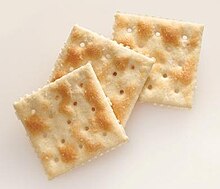Saltine cracker: Difference between revisions
Mike Rosoft (talk | contribs) Removed unreferenced folk remedy |
→History: Removed reference to SAO biscuits as these are a type of Cream Cracker NOT saltines (completely different) |
||
| Line 18: | Line 18: | ||
In the United States, the word "saltine" was originally registered as a [[trademark]] by Nabisco, which absorbed the Premium brand, but it lost trademark protection after the term began to be used generically to refer to similar crackers.{{Citation needed|date=November 2008}} In Australia, [[Arnott's Biscuits Holdings]] still holds a trademark on the name "Saltine." |
In the United States, the word "saltine" was originally registered as a [[trademark]] by Nabisco, which absorbed the Premium brand, but it lost trademark protection after the term began to be used generically to refer to similar crackers.{{Citation needed|date=November 2008}} In Australia, [[Arnott's Biscuits Holdings]] still holds a trademark on the name "Saltine." |
||
In the [[United Kingdom]] they were made by [[Huntley and Palmers]], also in [[Australia]] and [[New Zealand]] under Arnott's Salada |
In the [[United Kingdom]] they were made by [[Huntley and Palmers]], also in [[Australia]] and [[New Zealand]] under Arnott's Salada. |
||
==Baking process== |
==Baking process== |
||
Revision as of 07:30, 24 June 2012
This article needs additional citations for verification. (November 2009) |

A saltine or soda cracker is a thin, usually square cracker made from white flour, shortening, yeast, and baking soda, with most varieties lightly sprinkled with coarse salt. It has perforations throughout its surface, to allow steam to escape for uniform rising, and along the edges, as individual crackers are broken from larger sheets during manufacturing. It has a very dry and crisp texture, as it is made with less shortening than varieties such as Ritz crackers. Some familiar brand names of saltine crackers in North America are Christie's Premium Plus (Canada), Nabisco's Premium (U.S.), Sunshine's Krispy (U.S.) and Keebler's Zesta (U.S.). Unsalted tops as well as whole grain saltines can also be found.
Uses
Saltines are often eaten as a light snack, with cheese or peanut butter. They may also be dipped or crumbled in stews, chilis, soups or dips, or crumbled into salads. Typically they are sold in boxes containing two to four stacks of crackers wrapped in a sleeve of waxed paper or plastic. In restaurants, they are found in small wrapped packets of two crackers, which generally accompany soup or salad.
As a home remedy, saltines are consumed by many people in order to ease nausea and to settle an upset stomach. Pregnant women are also usually advised to snack on saltines. A common, but unconfirmed home remedy in the Bible Belt area of Midwestern America called "Chelt" is a combination of spearmint or menthol flavoring with a saltine cracker swallowed before breakfast to increase hair growth in men. For some children, eating Saltines on Christmas Eve is a family tradition. Saltine crackers have also been included in military field rations (MRE or Meal, Ready to Eat) in the USA.
History
The saltine cracker was invented by Joseph Garneau, Joseph Garneau Company Inc., manufacturers of biscuits and crackers. He died in 1917, age 66, in Kingston, New Jersey.[1]
Soda crackers, also called "premium flake" and "saltina" crackers, date back at least to the 19th century.[2] Premium Saltines, originally called Premium Soda Crackers, originated in 1876 in St. Joseph, Missouri.[3]
In the United States, the word "saltine" was originally registered as a trademark by Nabisco, which absorbed the Premium brand, but it lost trademark protection after the term began to be used generically to refer to similar crackers.[citation needed] In Australia, Arnott's Biscuits Holdings still holds a trademark on the name "Saltine."
In the United Kingdom they were made by Huntley and Palmers, also in Australia and New Zealand under Arnott's Salada.
Baking process
Saltines have been compared to hardtack, a simple unleavened cracker or biscuit made from flour, water, and salt. However, unlike hardtack, saltines actually do include yeast as one of their ingredients. Soda crackers are a leavened bread that is allowed to rise for twenty to thirty hours. After the rise, alkaline soda is added to neutralize the excessive acidity produced by the action of the yeast. The dough is allowed to rest for three to four more hours, to relax the gluten, before being rolled in layers and then baked.
